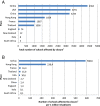School closures during the 2009 influenza pandemic: national and local experiences
- PMID: 24739814
- PMCID: PMC4021091
- DOI: 10.1186/1471-2334-14-207
School closures during the 2009 influenza pandemic: national and local experiences
Abstract
Background: School closure is a non-pharmaceutical intervention that was considered in many national pandemic plans developed prior to the start of the influenza A(H1N1)pdm09 pandemic, and received considerable attention during the event. Here, we retrospectively review and compare national and local experiences with school closures in several countries during the A(H1N1)pdm09 pandemic. Our intention is not to make a systematic review of country experiences; rather, it is to present the diversity of school closure experiences and provide examples from national and local perspectives.
Methods: Data were gathered during and following a meeting, organized by the European Centres for Disease Control, on school closures held in October 2010 in Stockholm, Sweden. A standard data collection form was developed and sent to all participants. The twelve participating countries and administrative regions (Bulgaria, China, France, Hong Kong Special Administrative Region (SAR), Italy, Japan, New Zealand, Serbia, South Africa, Thailand, United Kingdom, and United States) provided data.
Results: Our review highlights the very diverse national and local experiences on school closures during the A(H1N1)pdm09 pandemic. The processes including who was in charge of making recommendations and who was in charge of making the decision to close, the school-based control strategies, the extent of school closures, the public health tradition of responses and expectations on school closure varied greatly between countries. Our review also discusses the many challenges associated with the implementation of this intervention and makes recommendations for further practical work in this area.
Conclusions: The single most important factor to explain differences observed between countries may have been the different public health practises and public expectations concerning school closures and influenza in the selected countries.
Figures




References
-
- WHO. Measures in school settings. Available at http://www.who.int/csr/disease/swineflu/notes/h1n1_school_measures_20090.... Accessed on 4 Jan 2012. 2009.
-
- ECDC. Influenza pandemic preparedness. Available at http://ecdc.europa.eu/en/healthtopics/pandemic_preparedness/national_pan.... Accessed on 4 Jan 2012.
-
- Department of Health. Review of the evidence base underpinning the UK influenza pandemic preparedness strategy. Available at http://www.dh.gov.uk/en/Publicationsandstatistics/Publications/Publicati.... Accessed on 4 Jan 2012. 2011 [cited; Available from]
-
- Public Health Agency of Canada. The canadian pandemic influenza plan for the health sector. Available at http://www.phac-aspc.gc.ca/cpip-pclcpi/index-eng.php. Accessed on 4 Jan 2012.
-
- Government of Western Australia. Principles governing the closure of schools and other educational facilities in Western Australia during a human influenza pandemic. Available at http://www.public.health.wa.gov.au/cproot/2253/2/school%20closures.pdf. Accessed on 4 Jan 2012.
Publication types
MeSH terms
Grants and funding
LinkOut - more resources
Full Text Sources
Other Literature Sources
Medical
Miscellaneous

